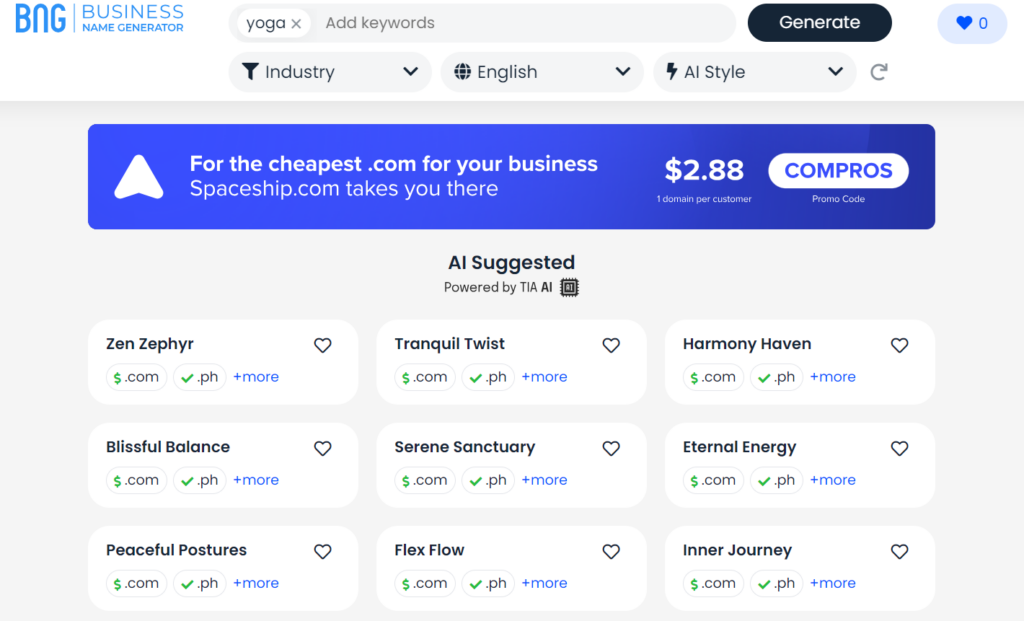Yoga Studio Name Generator Benefits

Quickly name your yoga company
The tool generates thousands of name ideas in 5 seconds.
Useful tools
It comes with a logo maker and domain availability checker.
Convenience and knowledge
Save your favorite yoga names and check for trademark issues.
Customization
Tailored filters to fit the unique selling points of your yoga business.
Top Tips
How to Name a Yoga Studio
Naming your yoga business is a vital step in establishing your brand. By leveraging our Yoga Business Name Generator and following these tips you will be well on your way to success.

Yoga Style
If you focus on a specific style of yoga, like Vinyasa, Hatha, or Ashtanga, consider including this in your name. This instantly tells potential clients what to expect and makes you easier to find if they are looking for that style of yoga.

Inspirational Words
Yoga is about balance, peace, and wellness. Think of words that convey these feelings, like “Harmony”, “Serenity’, ‘Bliss”, or “Tranquility”. Including them in your name can help customers paint a picture in their head of how they will feel after your yoga class.

Easy to Recommend
A good business name should be easy to remember and pronounce. Avoid overly complicated words or phrases. Help people find and recommend your yoga classes.

Consider Your Location
If your yoga studio is in a specific town or neighborhood, incorporating this into the name can give a sense of community and belonging. For example, ‘Riverside Yoga’ or ‘Downtown Zen’.

Check for Domain Availability
Having an online presence helps people time your services, class times and reviews. Check if the domain name is available for your yoga name.

Avoid Copying Others
Make sure your name is unique and not already in use by another yoga business. This helps in establishing your own identity and avoiding legal issues.
Get Inspired
20 Yoga Business Name Ideas
We generated calming yoga business name ideas using our Yoga Studio Name Generator.
- Blissful Balance
- Inner Harmony Studio
- Lotus Bloom Yoga
- Tranquil Trails Yoga
- Radiant Flow Center
- Mystic Mat Yoga
- Peaceful Poses
- Breathe Bliss Yoga
- Asana Adventures
- Zenith Zen Studio
- Serene Spirit Yoga
- Oasis of Om
- Flowing Force Yoga
- Unity Yoga Utopia
- Mindful Mornings
- Sunrise Salutations
- Elemental Asanas
- Nirvana Nook
- Yogic Yonder
- Zen Zone Yoga
Best Yoga Studio Names for Inspiration
We have analyzed five of our favorite yoga studio brand names to help show you what a successful yoga business name looks like—and shared why their names work so well.
| Yoga Brand Name | Why It Works |
|---|---|
| Good Vibes | The name appeals to the wellness market, promising customers to feel happier and calmer when interacting with this business. |
| Hidden House Yoga | This yoga studio is quite hidden, and the name has a sense of calmness. Customers feel this is a place to escape to to work on themselves and their wellbeing, away from the harsh realities of life. |
| Yasmin Yoga | This name works well because it uses alliteration, which can only be done with Y starting names. |
Body Soul Yoga | These yoga classes aim to make yoga fun and accessible for everyone, no matter your age, gender, or body type. |
| Lightspace Yoga | The business name makes people aware that when practicing yoga, they can do it in a safe and relaxing space. |

Get the Business Buzz
Subscribe to our newsletter for weekly business insights, including:
- Trending business news
- Exclusive subscriber perks
- Actionable growth tips
Toolbox
Relevant Name Generators and Articles
Take the First Step in Creating Your Business Name
Author
Methodology
- Industry-leading business name generator:
How does our generator work? Our tool uses an OpenAI API integration to generate creative, contextually relevant business names. We keep the users in mind and regularly test, update, and release new features to support them. - We have a team of experienced writers:
Our team of specialist in-house writers are here to share their knowledge and help your business get off the ground. - We offer value-added content:
Our team of experts has the passion and decades of expertise to write support guides, news, blogs, and videos to help you tackle setting up your new business. - We fact-check our content:
Our editorial team fact-checks every piece of information and uses industry-leading insights to include relevant, up-to-date stats and recommendations.

Leave a Reply